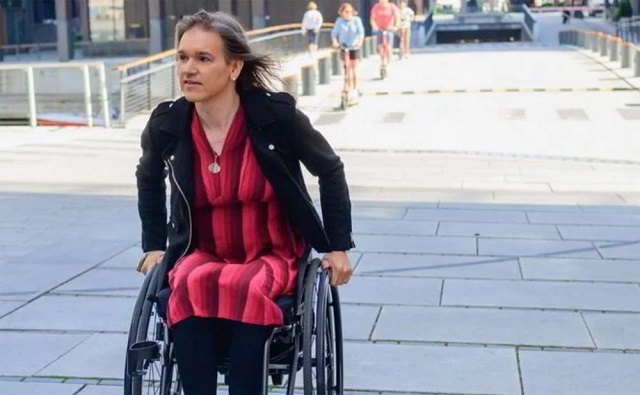Opinion
Transgender ideology has enabled people to ‘identify’ as amputees

Jørund ‘Viktoria’ Alme, a Norwegian man who believes he is a paralyzed woman
From LifeSiteNews
Those who challenge the view that a person can identify as an amputee despite being healthy must also challenge the assertion that one can simply identify as the opposite sex.
Almost ten years ago, I wrote a column in this space on the phenomenon of the so-called “transabled” – people who identify as amputees or suffer from a mental illness that causes them to loathe one of their healthy limbs. In 2022, a high-profile (alleged) example of this emerged when a 53-year-old healthy, non-disabled Norwegian man began identifying as a woman paralyzed from the waist down and took to a wheelchair to give media interviews.
Those who found his claims to be somewhat suspect were in a bit of a bind – which of his assertions, after all, is more ridiculous – that he is a woman, or that he is paralyzed? Our culture has accepted that he can claim to be a woman, and that we must all nod solemnly in response. “How brave of her,” we must all say in unison as his loyal wife pushes him away from the cameras in his wheelchair. “No, not the wife. The other one.”
A grimmer but no less disturbing profile was published recently by the National Post titled “Quebec man has two healthy fingers amputated to relieve ‘body integrity dysphoria.’” It’s a sad story; the young man said he had “intrusive thoughts about his left hand’s fourth and fifth fingers, the sensation they weren’t his, that they didn’t belong to his body” since he was a child and would even have nightmares about them. He fantasized about cutting them off himself. From the Post:
Instead, a surgeon at his local hospital agreed to an elective amputation in what is being called the first described case of ‘digits amputation’ for body integrity dysphoria, or BID, a rare and complex condition characterized by an intense desire to amputate a perfectly healthy body part, such as an arm or a leg. The Quebec case involved an ambidextrous 20-year-old whose attempts at ‘non-invasive’ relief, including cognitive behavioural therapy, Prozac-like antidepressants and exposure therapy, only increased his distress.
What is significant about this case is the way it was described by Dr. Nadia Nadeau of the department of psychiatry at Université Laval in a case study published in the journal Clinical Case Reports. Nadeau describes the young man’s mental and emotional distress, and notes that this distress apparently ceased after the “elective amputation” and that “he was able to pursue the life he envisioned as a complete human being without those two fingers bothering him.” One month post surgery, he had no regrets.
The particularly significant conclusion came towards the end of the report. According to Nadeau: “He is now living a life free from distressing preoccupations about his fingers, with all his symptoms related to BID resolved. The amputation enabled him to live in alignment with his perceived identity.” This, of course, is precisely the argument used by transgender activists making the case for sex change surgeries, cross-sex hormones, and puberty blockers – that these “treatments” will help the recipient “live in alignment with his perceived identity.” Although they wouldn’t call it a “perceived” identity – they’d call it his real identity. This perceived identity, however, was considered real enough that a surgeon removed two of his fingers.
The justifications for these “treatments” that include bodily mutilation are similar, as well. The Post noted that “Nadeau’s patient, after doing some research, ‘related his condition to gender dysphoria’… People with BID often feel their physical body doesn’t align with the image of the body they have in their minds.”
Furthermore, although “cutting off healthy, functioning body parts for psychological distress raises ethical concerns, BID sufferers sometimes resort to self-mutilation or ‘black-market’ amputations, risking their lives.”
A similar argument is made for “transgender care”: if extreme medical intervention does make the mentally ill person’s body resemble the image of reality in their minds, they might harm themselves. That’s the catch-22, of course. Isn’t surgical mutilation also harm, by definition? Not if you redefine it – that’s why trans activists no longer refer to sex change surgeries, but “gender-affirming care.” According to Nadeau: “Recognizing and addressing the unique needs of (BID) patients can lead to a future where they can live with more dignity, respect and optimal well-being.”
Who can disagree with a campaign to increase understanding and dignity for the mentally ill? I wonder, however, what the limiting principle is here. If a young man who believes himself to be a woman can get himself legally castrated by a surgeon, why can’t a man who believes he is an amputee have a leg removed? Or an arm? If we have accepted that people’s self-perceptions are more important than actual reality, where does it stop?
Frontier Centre for Public Policy
Tent Cities Were Rare Five Years Ago. Now They’re Everywhere

From the Frontier Centre for Public Policy
Canada’s homelessness crisis has intensified dramatically, with about 60,000 people homeless this Christmas and chronic homelessness becoming entrenched as shelters overflow and encampments spread. Policy failures in immigration, housing, monetary policy, shelters, harm reduction, and Indigenous governance have driven the crisis. Only reversing these policies can meaningfully address it.
Encampments that were meant to be temporary have become a permanent feature in our communities
As Canadians settle in for the holiday season, 60,000 people across this country will spend Christmas night in a tent, a doorway, or a shelter bed intended to be temporary. Some will have been there for months, perhaps years. The number has quadrupled in six years.
In October 2024, enumerators in 74 Canadian communities conducted the most comprehensive count of homelessness this country has attempted. They found 17,088 people sleeping without shelter on a single autumn night, and 4,982 of them living in encampments. The count excluded Quebec entirely. The real number is certainly higher.
In Ontario alone, homelessness increased 51 per cent between 2016 and 2024. Chronic homelessness has tripled. For the first time, more than half of all homelessness in that province is chronic. People are no longer moving through the system. They are becoming permanent fixtures within it.
Toronto’s homeless population more than doubled between April 2021 and October 2024, from 7,300 to 15,418. Tents now appear in places that were never seen a decade ago. The city has 9,594 people using its shelter system on any given night, yet 158 are turned away each evening because no beds are available.
Calgary recorded 436 homeless deaths in 2023, nearly double the previous year. The Ontario report projects that without significant policy changes, between 165,000 and 294,000 people could experience homelessness annually in that province alone by 2035.
The federal government announced in September 2024 that it would allocate $250 million over two years to address encampments. Ontario received $88 million for ten municipalities. The Association of Municipalities of Ontario calculated that ending chronic homelessness in their province would require $11 billion over ten years. The federal contribution represents less than one per cent of what is needed.
Yet the same federal government found $50 billion for automotive subsidies and battery plants. They borrow tonnes of money to help foreign car manufacturers with EVs, while tens of thousands are homeless. But money alone does not solve problems. Pouring billions into a bureaucratic system that has failed spectacularly without addressing the policies that created the crisis would be useless.
Five years ago, tent cities were virtually unknown in most Canadian communities. Recent policy choices fuelled it, and different choices can help unmake it.
Start with immigration policy. The federal government increased annual targets to over 500,000 without ensuring housing capacity existed. Between 2021 and 2024, refugees and asylum seekers experiencing chronic homelessness increased by 475 per cent. These are people invited to Canada under federal policy, then abandoned to municipal shelter systems already at capacity.
Then there is monetary policy. Pandemic spending drove inflation, which made housing unaffordable. Housing supply remains constrained by policy. Development charges, zoning restrictions, and approval processes spanning years prevent construction at the required scale. Municipal governments layer fees onto new developments, making projects uneconomical.
Shelter policy itself has become counterproductive. The average shelter stay increased from 39 days in 2015 to 56 days in 2022. There are no time limits, no requirements, no expectations. Meanwhile, restrictive rules around curfews, visitors, and pets drive 85 per cent of homeless people to avoid shelters entirely, preferring tents to institutional control.
The expansion of harm reduction programs has substituted enabling for treatment. Safe supply initiatives provide drugs to addicts without requiring participation in recovery programs. Sixty-one per cent cite substance use issues, yet the policy response is to make drug use safer rather than to make sobriety achievable. Treatment programs with accountability would serve dignity far better than an endless supply of free drugs.
Indigenous people account for 44.6 per cent of those experiencing chronic homelessness in Northern Ontario despite comprising less than three per cent of the general population. This overrepresentation is exacerbated by policies that fail to recognize Indigenous governance and self-determination as essential. Billions allocated to Indigenous communities are never scrutinized.
The question Canadians might ask this winter is whether charity can substitute for competent policy. The answer is empirically clear: it cannot. What is required before any meaningful solutions is a reversal of the policies that broke it.
Marco Navarro-Genie is vice-president of research at the Frontier Centre for Public Policy and co-author with Barry Cooper of Canada’s COVID: The Story of a Pandemic Moral Panic (2023).
Fraser Institute
How to talk about housing at the holiday dinner table

From the Fraser Institute
The holidays are a time when families reconnect and share cherished traditions, hearty meals and, occasionally, heated debates. This year, housing policy might be a touchy subject at the holiday dinner table. Homebuilding has not kept pace with housing demand in Canada, causing a sharp decline in affordability. Efforts to accelerate homebuilding are also changing neighbourhoods, sometimes in ways that concern residents. Add in a generational divide in how Canadians have experienced the housing market, and it’s easy to see how friends and family can end up talking past one another on housing issues.
Some disagreement about housing policy is inevitable. But in the spirit of the holidays, we can keep the conversation charitable and productive by grounding it in shared facts, respecting one another’s housing choices, and acknowledging the trade-offs of neighbourhood change.
One way to avoid needless conflict is to start with a shared factual baseline about just how unaffordable housing is today—and how that compares to the past.
The reality is that today’s housing affordability challenges are severe, but not entirely unprecedented. Over the past decade, prices for typical homes have grown faster than ordinary families’ after-tax incomes in nearly every major city. At the pandemic-era peak, the mortgage burden for a typical purchase was the worst since the early 1980s. The housing market has cooled in some cities since then, but not enough to bring affordability back to pre-pandemic levels—when affordability was already strained.
These facts provide some useful context for the holiday dinner table. Today’s aspiring homebuyers aren’t wrong to notice how hard it has become to enter the market, and earlier generations aren’t exaggerating when they recall the shock of double-digit interest rates. Housing affordability crises have happened in the past, but they are not the norm. Living through a housing crisis is not, and should not be, a generational rite of passage. Canada has had long periods of relative housing affordability—that’s what we should all want to work towards.
Even when we agree on the facts about affordability, conflicts can flare up when we judge one another’s housing choices. Casual remarks like “Who would want to live in a shoebox like that?” or “Why would anyone pay that much for so little?” or “Why are you still renting at your age?” may be well-intentioned but they ignore the constraints and trade-offs that shape where and how people live.
A small townhome with no yard might seem unappealing to someone who already owns a single-detached house, but for a first-time homebuyer who prioritizes living closer to work or childcare, it might be the best option they can afford.
At first glance, a new condo or townhome might look “overpriced” compared with nearby older single-family homes that offer more space. But buyers must budget for the full cost of ownership, including heating bills, maintenance and renovations, which can make the financial math on some “overpriced” new homes pencil out.
And renting isn’t necessarily a sign that someone is falling behind. Many renters are intentionally keeping their options open: to pursue job opportunities in other cities, to sort out their romantic lives before committing to homeownership, or to invest their money outside of real estate.
This isn’t just a dinner-table issue. The belief that “no one wants to live like that” leads some to support policies restricting apartments, townhomes or purpose-built rentals on the premise that they’re inherently undesirable. A better approach is to set fair rules and let builders respond to what Canadian families choose for themselves—not what we think they should want.
The hardest housing conversations are about where new homes should go, and who gets a say as neighbourhoods change.
It’s natural for homeowners to feel uneasy about how their neighbourhoods might change as a consequence of housing redevelopment. But aspiring homebuyers are also right to be frustrated when local restrictions prevent the kinds of homes Canadian families want from being built in the places they want to live. The economics is clear—allowing more housing styles to be built in more places means greater options and lower prices for renters and homebuyers.
There’s no simple way to balance the competing views of existing residents and aspiring homebuyers. But the conversation becomes more productive if both sides recognize an unavoidable trade-off—resistance to neighbourhood change reliably restricts housing options and makes housing less affordable, but redevelopment can entail real downsides for existing residents.
Everyone wants better housing outcomes for Canadian families, but we won’t get them by talking past one another. If we bring empathy to the table and stay clear eyed about the trade-offs, we’ll collectively make better housing policy decisions—and have calmer holiday dinners.
-

 armed forces15 hours ago
armed forces15 hours agoOttawa’s Newly Released Defence Plan Crosses a Dangerous Line
-

 espionage14 hours ago
espionage14 hours agoCarney Floor Crossing Raises Counterintelligence Questions aimed at China, Former Senior Mountie Argues
-

 Health13 hours ago
Health13 hours agoAll 12 Vaccinated vs. Unvaccinated Studies Found the Same Thing: Unvaccinated Children Are Far Healthier
-

 Energy16 hours ago
Energy16 hours ago75 per cent of Canadians support the construction of new pipelines to the East Coast and British Columbia
-

 Energy2 days ago
Energy2 days ago‘The electric story is over’
-

 Business2 days ago
Business2 days agoSome Of The Wackiest Things Featured In Rand Paul’s New Report Alleging $1,639,135,969,608 In Gov’t Waste
-

 Energy1 day ago
Energy1 day agoWestern Canada’s supply chain for Santa Claus
-

 Opinion12 hours ago
Opinion12 hours agoPope Leo XIV’s Christmas night homily







